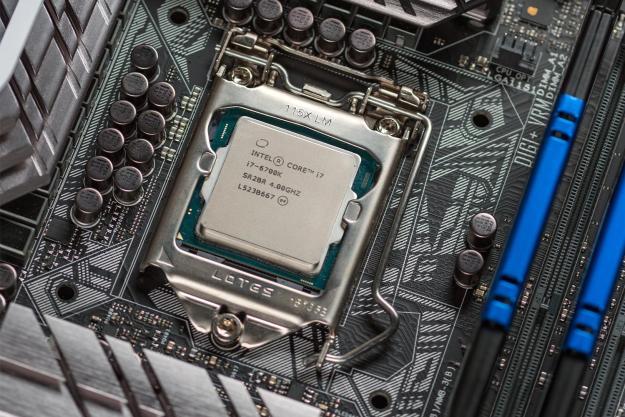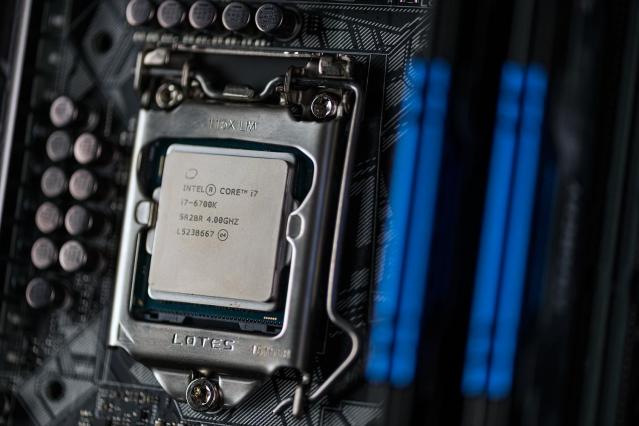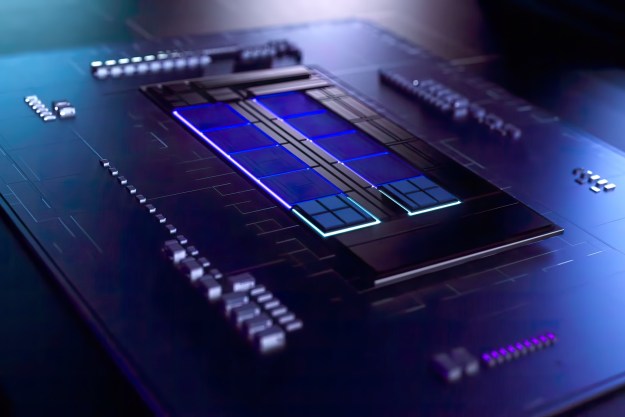
“The Core i7-6700K is the quickest quad-core chip yet, but not a major improvement over its predecessor.”
- Quickest Intel quad-core yet
- Versatile new Z170 chipset
- Improved IGP performance
- Not a major upgrade over the i7-4790K
- Expensive
Update August 6th 08/06/2015: While doing additional testing to update our Intel HD graphics comparison, I noted problems with performance in Civilization: Beyond Earth. Investigating this further indicated an improperly selected setting decreased the Core i7-6700K’s first round of test results. This review has been updated with new results, but the score has not changed as a result.
Intel’s processor-release schedule has been a bit wonky as of late. The 4th-generation Core chips were released to desktop back in 2013, and they held down the fort for nearly two years. In June of this year, Intel released two new fifth-gen Core desktop chips – and now, two months later, the sixth generation has arrived. When it rains it pours.
Buy it now from:
This unusual release schedule, the result of production delays on fifth-generation chips, has left desktop users waiting for an upgrade. It also means the desktop virtually skipped a generation. Yes, the chips did eventually make their way to the desktop, but enthusiasts stayed away. Everyone already knew the next big thing was just a couple months away.
Now that next big thing – Skylake – is here, and Intel is leading with desktop hardware first. Today’s debut centers on just two processors, the Core i7-6700K and the Core i5-6600K. These chips target enthusiasts and, more specifically, gamers.
This review covers the more powerful i7-6700K, a quad-core chip with a stock clock of 4GHz, a maximum Turbo Boost of 4.2GHz, and Hyper-Threading support. On paper it’s an impressive chip, but is it enough to warrant an upgrade from a third or fourth-gen Core quad?
One small step for the architecture
Over the past eight years, Intel has pushed itself forward through a product plan called “tick-tock.” A “tick” improves the production process, while a “tock” is a major architecture revision. Skylake is the latter, though the slim selection of Broadwell desktop hardware means that, in practice, it’s a combination of both. Intel seems to acknowledge that by comparing the i7-6700K to the Core i7-4790K in its official press documents, rather than the Core i7-5775C.
While many of the features, such as Turbo Boost and Hyper-Threading, are by now familiar, there are a few new additions. The most significant, and unique to the K-series desktop chips, is “full range base clock tuning granularity.” Put simply, Intel has made it possible for users to change processor frequency in 1MHz steps, if such granularity is desired. This will help enthusiasts push the chip right up to the edge of stability. This is supported by more granular RAM overclocking. Users used to be able to overclock in 200/266 MHz increments – that’s been lowered to 100/133MHz.
The other major changes come at the platform level. Skylake is debuting alongside a chipset called Z170, which uses the new LGA1151 processor socket. This means the hardware is not backwards compatible with previous motherboards, as was Broadwell – you’ll need a new motherboard to go with the Core i7-6700K.
One giant leap for the chipset
While that’s annoying, the Z170’s feature set makes it sensible. DDR4
The Z170 should be able to handle gobs of extra storage and devices without feeling a bandwidth pinch.
Z170 is the leading edge of Intel’s new mainstream chipsets, so its adoption of DDR4 signals impending, wide-spread adoption of the new memory standard. Switching to a new memory standard has its costs, but in this case they’re forgivingly minimal. Two 4GB sticks of DDR 1333 memory can be had for $40. A similar pair of DDR4 2133, the most affordable version, will set you back $50. That’s a very small price differential, so the “hidden cost” of upgrading to the new chipset is minimal.
Users can pair the Z170 with DDR3 on certain motherboards, as the chipset does technically provide support. However, DDR4 and DDR3 slots are not compatible with each other. It’s expected that most motherboard makers will offer DDR4 only, or a combination of both.
The chipset also provides a substantial upgrade to PCI Express bandwidth. Intel’s Z97 chipset, its former mainstream flagship, could handle eight PCI Express 2.0 lanes with 5Gbp/s of bandwidth each. Z170 expands support to 20 lanes of PCI Express 3.0 with 8Gbp/s of bandwidth each.
Gamers are not the target of this upgrade as the Z170, like its predecessor, can handle only a single graphics card at full PCIe x16 speed, or two at 8x. Instead, these lanes are for other peripherals, including PCI Express cards, Non-Volatile Memory Express hard drives, and Thunderbolt peripherals. The Z170 should be able to handle gobs of extra storage and devices without feeling a bandwidth pinch.
Last, but not least, is the chip’s integrated graphics. The Core i7-6700K comes with Intel HD 530 clocked at 1,150 MHz, and the company claims up to a 40-percent improvement over Intel HD Graphics 4000 as found in the Core i7-3770K. This isn’t the spotlight in the release, no doubt because Intel knows enthusiasts will be pairing the chip with a discrete
Price and positioning
While the Core i7-6700K isn’t shipping with an over-the-top code name, like last year’s Devil’s Canyon chips, it may as well have. Intel’s press deck hit my inbox covered in images of young, enthusiastic gamers making funny faces at an unseen screen. That makes sense. Gamers are among the most likely to overclock a chip. They appreciate the extra performance, and are less concerned with occasional instability than enterprise or workstation customers.
If it’s slower than stated, it’s not a great value; if it’s quicker, it’ll prove more appealing than thought.
An enthusiast focus means an enthusiast price tag. The Core i7-6700K will ship with a “recommended customer pricing” of $350, while the i5-6600K will ship at $243. That gives the i7-6700K the same initial MSRP as Devil’s Canyon, though the Core i7-4790K is now only $339 on Amazon. Counting DDR4
AMD doesn’t have a chip that’s comparable to the 6700K. Its FX-9590, which boasts eight cores clocked at 4.7GHz, is the closest competitor, and on it paper it seems to compare favorably. In reality, though, the FX has difficulty keeping up with mid-range, fourth-generation Intel quads. The 6700K is in a different league.
Our test system
Because Skylake is a new architecture on a new platform, it’s not compatible with the Falcon Northwest Talon test rig we’ve used for so long. As such, we put together a new system for the purpose of testing the i7-6700K. We thank Asus for providing its excellent Z170-Deluxe motherboard, and EVGA for providing a GTX 980 Ti video card. The system also included 8GB of DDR4
Processor performance
Intel says that the Core i7-6700K should be 10 percent quicker than the i7-4790K, and is priced as such. If it’s slower than stated, it’s not a great value; if it’s quicker, it’ll prove more appealing than thought. What does Geekbench have to say?
Surprisingly, the 6700K did not outperform the 4790K in single-core performance in this benchmark, though the results falls within the margin of error. That only seems surprising because of Intel’s claims. While the 6700K is newer, the 4790K has an identical 4GHz base clock and higher 4.4GHz maximum Turbo Boost (the 6700K caps at 4.2GHz).
When it came to multi-core performance, however, the 6700K defeats the 4790K, managing a lead of about 5 percent. That’s not as high as Intel’s claimed 10-percent increase, and is rather disappointing, at least for those hoping to the sixth generation would be a major upgrade.
When compared to the rest of the field, the 6700K does well. It outperforms everything in single-core performance aside from the 4790K, and also defeats everything in multi-core performance aside from the octo-core 5690X. The new Core i7 is a strong performer on the whole, and would be a major upgrade for someone with a second-generation or first-generation Core chip.
Game Testing
There’s more to the Core i7-6700K than just the CPU cores, of course. It also has Intel’s HD 530 graphics, the new generation. Intel is not heavily promoting this because it doesn’t fit into the launch’s focus on gamers, but the company claims a significant performance boost. Even if this isn’t relevant to most buyers of the i7-6700K, it is relevant to desktops as a whole, because HD 530 will likely appear in a variety of chips when more Skylake chips hit retailer later this year.
For this comparison, we used previous test results from our Intel HD comparison article. We also threw in A10-7870K, which represents the best integrated graphics AMD has to offer.
World of Warcraft
Blizzard’s massively multiplayer game is now 10 years old, so you might think it’s a pushover. Certainly that’s true for most discrete GPUs, but constant updates to the game’s graphics have kept it a challenge for integrated graphics to overcome. Let’s see how HD 530 stands up.
These results are strong. World of Warcraft is playable at all tested settings aside from 1080p and the High preset, and at 1,366 x 768 the HD 530 nearly competes with AMD’s A10-7870K, which features a capable Radeon integrated GPU. Intel’s off to a good start.
Civilization: Beyond Earth
While Beyond Earth isn’t the most attractive game on the planet, it can be demanding, especially in late-game scenarios with a large number of units on-screen. The quickest Intel IGP we’ve tested in this game, HD 6000, manages just 10 FPS at 1080p and High Detail, and barely cracks 30 FPS at low. Does HD 530 fare better?
Again, HD 530 offers improvement over most preceding Intel HD offerings. At 1,366 x 768 and minimum detail, the new IGP offers 14 additional frames per second over Intel HD 6000, and over 20 FPS over Intel HD 5500. It enjoys a just slightly narrower advantage at 1080p and low detail.
Theses advantages are quite noticeable in-game. Beyond Earth isn’t really enjoyable on other IGPs aside from HD 6000, and even that was clear the bar of minimum acceptable performance by a hair. HD 530 offers some buffer room, providing the chance to slightly up detail, or just sit back and enjoy a smoother experience.
Battlefield 4
Now, we come to the most challenging trial, DICE’s epic first-person shooter. While it’s now far from the most demanding game available, it’s a lot for integrated graphics to handle. Intel IGPs haven’t exceeded 30 FPS in our past tests, even at 1,366 x 768 resolution and low detail.
The improvement here is significant: An Intel HD 530 delivers a playable experience at 1,366 x 768 and low detail. It even comes within a hair of enjoyable at 1080p and low, as the new IGP delivers 10 additional frames per second over HD 5500 or HD 6000.
Again, though, there’s a catch. The HD 530 posts some serious improvements, but it also comes in well behind AMD’s APU, and isn’t quite capable of handling Battlefield 4 at 1080p. Still, these results offer hope that the next generation of Iris graphics, Intel’s high-end IGP, will prove capable.
Conclusion
The DT Accessory Pack
Up your game and the get the most out of your gear with the following extras, hand-picked by our editors:
Thermalrite Macho Rev.B cooler ($52.90)
This massive air cooler from Thermalright requires a large case, but provides excellent cooling and is easy to install.
Asus Z170 Deluxe motherboard (TBA)
The Asus Z170 is an excellent motherboard for the i7-6700K thanks to its versatile UEFI BIOS and numerous connectivity options.
Corsair Vengeance LPX 16GB ($150)
This
EVGA GTX 980 Ti Superclocked ($634.39)
Want to game? EVGA’s GTX 980 Ti plays well with the i7-6700K, and ensures you have the best experience possible.
Intel’s Skylake launch continues the company’s recent trend of incremental upgrades. Geekbench did not find the Core i7-6700K to be notably quicker than the i7-4790K. The upgrade provided by Intel’s HD 530 graphics is more significant – but the IGP remains unsuited for serious 3D gaming.
For some users, the more notable improvements may come from the chipset. Aside from DDR4
Overclocking is an area of performance I didn’t have time to dive into. Certainly, the platform provides more fine-grain detail in tuning, which is appreciated. But it’s also a separate issue from the overclocking limits of the chip. The stock clock of 4GHz is strong, and Intel chips from the last few generations have struggled to exceed 4.5GHz without extreme cooling and/or voltage tweaks. I hope to test this further in the coming weeks.
At stock clocks, the Core i7-6700K left me feeling ambivalent. Every new generation of Intel hardware is an upgrade over the last, but the improvements have become so minor that they feel inconsequential. Users who have a fourth-generation Core chip will see no reason to upgrade. Even those on a third or second generation chip may not feel persuaded by these results.
If you’re looking to build or buy an all-new system, though, the Core i7-6700K is an obvious choice. The Z170 platform it pairs with is a clear upgrade over Z97, and the processor itself is the strongest Intel quad yet – if only by a hair. While the degree of improvement it represents over the Core i7-4790K is not impressive, Intel’s latest high-end chip is, as expected, the new king of quad-core performance.
Highs
- Quickest Intel quad-core yet
- Versatile new Z170 chipset
- Improved IGP performance
Lows
- Not a major upgrade over the i7-4790K
- Expensive
Editors' Recommendations
- Intel CPU gaming crashes are causing an uproar
- Microsoft’s Surface Laptop Studio 2 might get a massive performance boost
- Intel’s Core i9-13900KS hits 6GHz out of the box, but there’s a catch
- Intel’s upcoming laptop CPU may destroy even the best desktop chips
- Intel accidentally leaks Raptor Lake specs, with one major surprise




